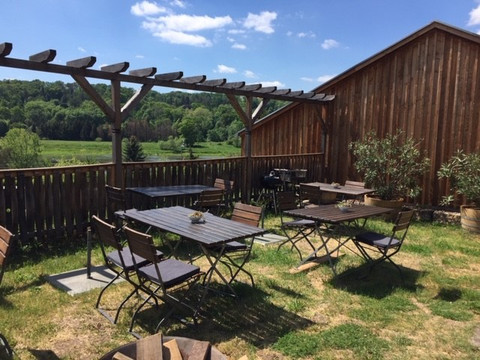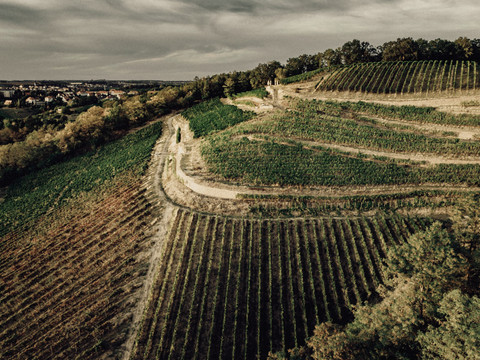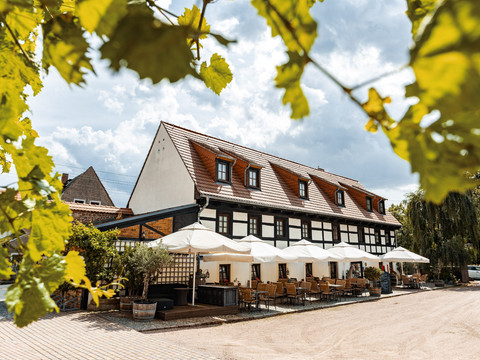From Niederau station, Germany's oldest railroad station (built in 1842), with public transport connections, it is a short walk to Oberau (water) castle, the starting point of the 5th stage (approx. 1.5 km walk from the station over the overpass over the tracks, right along the path parallel to the tracks, left into Mönchsallee, right into Oberauer Straße, left into Thomas-Müntzer-Ring).
From (Wasser)Schloss Oberau, we follow Thomas-Müntzer-Ring across the castle pond to the west (past the park with playground) and turn left at the park exit (at the agricultural field) into Teichstraße and follow this to Niederau, where we pass the Schwemmteich pond.
We reach Gröberner Straße, walk down it a short distance, turn right and continue along Kirchstraße.
Side trip: From the corner of Teichstraße and Gröberner Straße, it is approx. 1 km on foot up Gröberner Straße to Loose's Besenschänke (please enquire about opening times on 03521/738054) and from there another approx. 1 km on foot to the Steffen Loose winery itself (via Gröberner Straße, Baderberg, Im Winkel) with its nearby handicraft house.
At the beginning of Kirchstraße, we see St. Jakobus Church, which dates back to 1878/79 and is well worth a visit. 200 m further on, we turn left across the Niederau village stream and continue along the path as marked by the signposts to the end of the village (Hauptstraße, crossing Meißner Straße, Rathenaustraße), where we notice a tower windmill (2nd half of the 19th century, privately owned/residential building).
We continue along the Mittelweg through the Nassau, a landscape conservation area with wet meadows, crossing the Fürstengraben and the railroad line to Meißen and reach Ziegelstraße/Köhlerstraße (district road K8015). We turn left and walk along the footpath/cycle path next to the district road until we reach a crossing aid. We change sides of the road, turn right and continue along Köhlerstraße and Langer Graben, which take us to Meißen-Zaschendorf. We come to Heinrich-Heine-Straße, turn right and follow the road until we reach Großhügelstraße.
Here you can take a short detour to the village square in Zaschendorf with its pond, playground and rest area (go down Neuzaschendorf street a short distance).
To continue our route, we turn left onto Großhügelstraße and follow the signposts until we reach the Spaargebirge. This almost 3 km long mountain range rises up to 90 m above the Elbe and has favorable climatic conditions compared to the surrounding countryside. For this reason, farms, knights' estates and vineyards have settled here in unusually high numbers since time immemorial (documented from 1352), particularly on the south-facing slopes. These traces can only be discovered with the help of someone who knows the history of the area. Without help, we reach the vineyards and wineries, which also offer individual or guided walks through otherwise inaccessible vineyards.
We turn left into Gelegegasse, which merges into Boselweg and follow Boselweg until we come to a bench and signposts, where the path leads us right up into the forest and to Bosel with the botanical garden (founded in 1930, now managed by the TU Dresden, special features: drought-loving plants, opening hours: April-October every Wednesday, Saturday and Sunday 10 a.m. to 5 p.m.) and the Boselspitze viewpoint - with views of the Elbe valley and, on a clear day, as far as Dresden and Saxon Switzerland.
From the Boselspitze, we continue in the direction of Meißen. After just 200 m, we cross one of the Bronze Age ramparts, of which there are several in the Meissen area. Through a large, mostly closed gate, we have a view of the "Schwalbennest" winegrower's cottage. After a short time, we reach the Boselspitze guest house with its Bosel tower and beer garden, which invites us to take a break (open Friday-Sunday & public holidays). We continue along the Boselweg until we turn left onto the Rautenbergweg.
We can enjoy the magnificent views of the Elbe by taking a detour to the "Juchhöh" viewpoint (approx. 10 min. walk).
As small as the Spaargebirge is, it offers numerous marked hiking trails with different "descents" in all directions. We follow the markings of the Saxon Wine Trail (red grape logo with a red S above it) and reach Lückenhübelstraße via Rautenbergweg and arrive at the Ricco Hänsch winery.
Following the further markings (Lückenhübelstraße, right into Rodelandweg), we come to Oberspaarer Straße (refreshment stop: "Bauernhäusl" 1639 with historic wine tavern), cross it and continue along Alte Spaargasse, which leads onto Dresdner Straße.
At the corner of Alte Spaargasse/An der Spaargasse, there is an opportunity to take a detour to the Mariaberg winery.
We cross Dresdner Straße and follow it down the Elbe towards the city, before taking the Elbe cycle path a little later and walking along it to Elbberg Straße (in summer: beach bar with food and drink and beach volleyball court). Turn right up the Elbberg, crossing Dresdner Straße at the traffic lights, to Meißen railroad station and bus station, which offer various options for getting home (S-Bahn S1 towards Coswig, Radebeul, Dresden & bus station with various bus connections). You can stay overnight at the Hotel Ross opposite the train station or the Dorint Parkhotel Meißen (approx. 1 km walk via Großenhainer Straße, Bahnhofstraße, Zscheilaer Straße, Hafenstraße) or numerous accommodation options in the historic old town of Meißen (other side of the Elbe, accessible via the railroad bridge or old town bridge, approx. 10 min walk).
Or - if it's not too late - we decide to visit the WeinErlebnisWelt of the Sächsische Winzergenossenschaft Meißen (approx. 1.5 km walk via Großenhainer Straße, left into Gartenstraße, right into Zscheilaer Straße, right into Joachimstal Straße, left into Bennoweg), the largest wine producer in Saxony. Guided tours of the historic cellars are offered here, wines from all of Saxony's single and large vineyards are available for sale in the modern vinotheque and a wide range of events lives up to the name "WeinErlebnisWelt".







